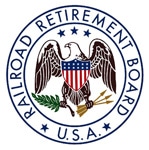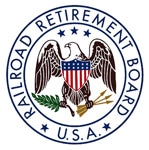
 Employers and employees covered by the Railroad Retirement Act pay higher retirement taxes than those covered by the Social Security Act. As a result, Railroad Retirement benefits are higher than Social Security benefits, especially for “career” employees (those employees who have 30 or more years of service).
Employers and employees covered by the Railroad Retirement Act pay higher retirement taxes than those covered by the Social Security Act. As a result, Railroad Retirement benefits are higher than Social Security benefits, especially for “career” employees (those employees who have 30 or more years of service).
The following questions and answers show the differences in Railroad Retirement and Social Security benefits payable at the close of the fiscal year ending Sept. 30, 2020. They also show the differences in age requirements and payroll taxes under the two systems.
1. How do the average monthly Railroad Retirement and Social Security benefits paid to retired employees and spouses compare?
The average age annuity being paid by the Railroad Retirement Board (RRB) at the end of fiscal year 2020 to career rail employees was $3,735 a month, and for all retired rail employees the average was $2,985. The average age retirement benefit being paid under Social Security was approximately $1,505 a month. Spouse benefits averaged $1,090 a month under Railroad Retirement compared to $765 under Social Security.
The Railroad Retirement Act also provides supplemental Railroad Retirement annuities of between $23 and $43 a month, which are payable to employees with railroad service prior to October 1981 who retire directly from the rail industry with 25 or more years of service.
2. Are the benefits awarded to recent retirees generally greater than the benefits payable to those who retired years ago?
Yes, because recent awards are based on higher average earnings. Age annuities awarded to career railroad employees retiring in fiscal year 2020 averaged about $4,370 a month while monthly benefits awarded to workers retiring at full retirement age under Social Security averaged nearly $2,070. If spouse benefits are added, the combined benefits for the employee and spouse would total $6,115 under Railroad Retirement coverage, compared to $3,105 under Social Security. Adding a supplemental annuity to the railroad family’s benefit increases average total benefits for current career rail retirees to about $6,135 a month.
3. How much are the disability benefits currently awarded?
Disabled railroad workers retiring directly from the railroad industry in fiscal year 2020 were awarded $3,160 a month on average while awards for disabled workers under Social Security averaged $1,415.
While both the Railroad Retirement and Social Security Acts provide benefits to workers who are totally disabled for any regular work, the Railroad Retirement Act also provides disability benefits specifically for employees who are disabled for work in their regular railroad occupation. Employees may be eligible for such an occupational disability annuity at age 60 with 10 years of service, or at any age with 20 years of service.
4. Can railroaders receive benefits at earlier ages than workers under Social Security?
Railroad employees with 30 or more years of creditable service are eligible for regular annuities based on age and service the first full month they are age 60, and rail employees with less than 30 years of creditable service are eligible for regular annuities based on age and service the first full month they are age 62.
No early retirement reduction applies if a rail employee retires at age 60 or older with 30 years of service and his or her retirement is after 2001, or if the employee retired before 2002 at age 62 or older with 30 years of service.
Early retirement reductions are otherwise applied to annuities awarded before full retirement age (the age at which an employee can receive full benefits with no reduction for early retirement). Full retirement age is age 66 for those born 1943 through 1954 and is gradually rising to age 67 for those born in 1960 or later, the same as under Social Security.
Under Social Security, a worker cannot begin receiving retirement benefits based on age until age 62, regardless of how long he or she worked, and Social Security retirement benefits are reduced for retirement prior to full retirement age regardless of years of coverage.
5. Can the spouse of a railroader receive a benefit at an earlier age than the spouse of a worker under Social Security?
If a retired railroad employee with 30 or more years of service is age 60, the employee’s spouse is also eligible for an annuity the first full month the spouse is age 60. The spouse of a worker under Social Security is not eligible for a spouse benefit based on age until both the worker and the spouse are at least age 62. Regardless of age, the spouses of workers under both retirement systems are eligible if the worker is retired and the spouse is caring for a qualifying child.
6. Does Social Security offer any benefits that are not available under Railroad Retirement?
Social Security does pay certain types of benefits that are not available under Railroad Retirement. For example, Social Security provides children’s benefits when an employee is disabled, retired or deceased, whereas the RRB only pays children’s benefits if the employee is deceased.
However, the Railroad Retirement Act includes a special minimum guaranty provision, which ensures that railroad families will not receive less in monthly benefits than they would have if railroad earnings were covered by Social Security rather than Railroad Retirement laws. This guaranty is intended to cover situations in which one or more members of a family would otherwise be eligible for a type of Social Security benefit that is not provided under the Railroad Retirement Act. Therefore, if a retired rail employee has children who would otherwise be eligible for a benefit under Social Security, the employee’s annuity can be increased to reflect what Social Security would pay the family.
7. How much are monthly benefits for survivors under Railroad Retirement and Social Security?
Survivor benefits are generally higher if payable by the RRB rather than Social Security. At the end of fiscal year 2020, the average annuity being paid to all aged and disabled widow(er)s was $1,825 a month, compared to $1,380 under Social Security.
Benefits awarded by the RRB in fiscal year 2020 to aged and disabled widow(er)s of railroaders averaged about $2,340 a month, compared to approximately $1,355 under Social Security.
The annuities being paid at the end of fiscal year 2020 to widowed mothers/fathers averaged $1,990 a month and children’s annuities averaged $1,195, compared to $1,030 and $900 a month for widowed mothers/fathers and children, respectively, under Social Security.
Those awarded in fiscal year 2020 averaged $1,780 a month for widowed mothers/fathers and $1,545 a month for children under Railroad Retirement, compared to $1,015 and $905 for widowed mothers/fathers and children, respectively, under Social Security.
8. How do Railroad Retirement and Social Security lump-sum death benefit provisions differ?
Both the Railroad Retirement and Social Security systems provide a lump-sum death benefit. The Railroad Retirement lump-sum benefit is generally payable only if survivor annuities are not immediately due upon an employee’s death. The Social Security lump-sum benefit may be payable regardless of whether monthly benefits are also due. Both Railroad Retirement and Social Security provide a lump-sum benefit of $255. However, if a railroad employee completed 10 years of creditable railroad service before 1975, the average Railroad Retirement lump-sum benefit payable is $1,030. Also, if an employee had less than 10 years of service, but had at least 5 years of such service after 1995, he or she would have to have had an insured status under Social Security law (counting both Railroad Retirement and Social Security credits) in order for the $255 lump-sum benefit to be payable.
The Social Security lump sum is generally only payable to the widow(er) living with the employee at the time of death. Under Railroad Retirement, if the employee had 10 years of service before 1975, and was not survived by a living-with widow(er), the lump sum may be paid to the funeral home or the payer of the funeral expenses.
9. How do Railroad Retirement and Social Security payroll taxes compare?
Railroad Retirement payroll taxes, like Railroad Retirement benefits, are calculated on a two-tier basis. Rail employees and employers pay Tier I taxes at the same rate as Social Security taxes, 7.65%, consisting of 6.20% for retirement on earnings up to $142,800 in 2021, and 1.45% for Medicare hospital insurance on all earnings. An additional 0.9% in Medicare taxes (2.35% in total) will be withheld from employees on earnings above $200,000.
In addition, rail employees and employers both pay Tier II taxes, which are used to finance Railroad Retirement benefit payments over and above Social Security levels. In 2021, the Tier II tax rate on earnings up to $106,200 is 4.9% for employees and 13.1% for employers.
10. How much are regular Railroad Retirement taxes for an employee earning $142,800 in 2021 compared to Social Security taxes?
The maximum amount of regular Railroad Retirement taxes that an employee earning $142,800 can pay in 2021 is $16,128, compared to $10,924.20 under Social Security. For railroad employers, the maximum annual regular retirement taxes on an employee earning $142,800 are $24,836.40, compared to $10,924.20 under Social Security. Employees earning over $142,800 and their employers will pay more in retirement taxes than the above amounts because the Medicare hospital insurance tax is applied to all earnings.
Related News
- Colorado bill criminalizing transit assault one step closer to becoming law
- Honoring the Legacy of Brother John A. Saunders
- Colorado Transit Worker Safety Bill (House Bill 25-1290)
- Kansas funds passenger rail expansion
- Maryland Passes Monumental Transit Safety Bill
- Brother Wirth Crowned Champion in 168-Pound Masters Division Victory
- Chairman Pauli Announces Retirement, SMART-TD celebrates his career
- New Mexico Local 1687 sets new precedent with Red Apple Transit
- Tentative Agreement Reached With TransitAmerica Services (TASI)
- Make sure your voice is heard, update your contact information